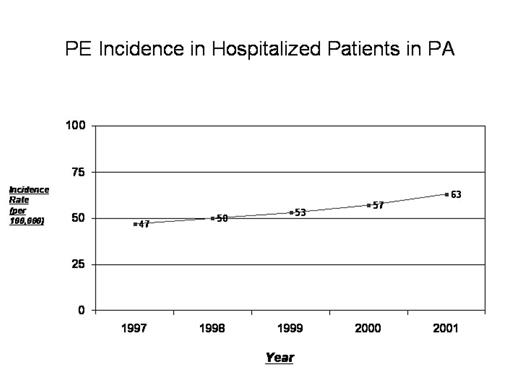Abstract
Pulmonary embolism (PE) is a major cause of morbidity in hospitalized patients, yet few data exist on PE incidence and characteristics among hospitalized patients. If those at greatest risk were able to be identified, early prevention might improve health outcomes. We, therefore, analyzed statewide discharge data from all hospitals in Pennsylvania on patients with PE, 1997-2001, collected by the Pennsylvania Health Care Cost Containment Council (PHC4) for clinical factors, Atlas severity of illness scores, and trends associated with PE. All non-pregnant Pennsylvania residents hospitalized for PE with the following ICD-9 PE-specific diagnostic codes were included in the analyses: 415.11 and 415.19. Diagnostic procedures were determined on the dataset by revenue codes, specifically for x-ray, chest x-ray, arteriography, nuclear medicine, and CT scan (including spiral CT). Total PE discharges were enumerated by age, race, and sex by year. The analysis was refined to exclude second or later admissions for PE. No subject identifiers or linkage codes were recorded or linked to the dataset. Severity of illness was determined by MediQual Atlas Admission Severity Categories and was analyzed for trends of malignancy, trauma, surgery, and fractures. The incidence of PE discharges among Pennsylvania residents increased from 47 to 63 per 100,000, a mean increase of 0.004% per year, p<0.001. Factors associated with greater PE incidence over the period included African American race (mean 0.031% per year higher than Caucasian), age ≥70 years (mean 0.007% higher than age <70 years), and female gender (0.013% higher than males), all p<0.001. During the same period, the proportion of PE patients undergoing CT scan increased from 19.21% to 41.36%, while rates for other procedure/revenue codes showed no proportionate increase. In a multivariate logistic regression model controlling for age, gender, race, and cancer, there was an increased likelihood over the 5-year period of having a CT scan, OR = 1.30, p<0.001. Comparing 1999 and before with 2000 and after, there was a significant decrease in the two highest Atlas severity of illness categories (49.4% to 37.7%) and a significant increase in the three lowest categories (50.6% to 62.3%), p<0.001, a trend that persisted after controlling for age, gender, and race. During the same period, the proportion of in-hospital deaths among PE patients decreased from 12.8% (1999 and before) to 11.1% (2000 and after), p<0.001. There was no proportionate increase in cancer, CHF, trauma, or fractures over the same period, which persisted after controlling for age, race, and gender. In conclusion, increasing rates of PE in hospitalized patients in Pennsylvania have occurred in parallel with increasing rates of CT scan (including spiral CT) procedures and were accompanied by lower severity of illness scores and lower mortality rates. Further studies will be required to determine the relationship of these factors to the increasing incidence of PE.
PE incidence in Hospitalized Patients in PA
Author notes
Corresponding author


This feature is available to Subscribers Only
Sign In or Create an Account Close Modal